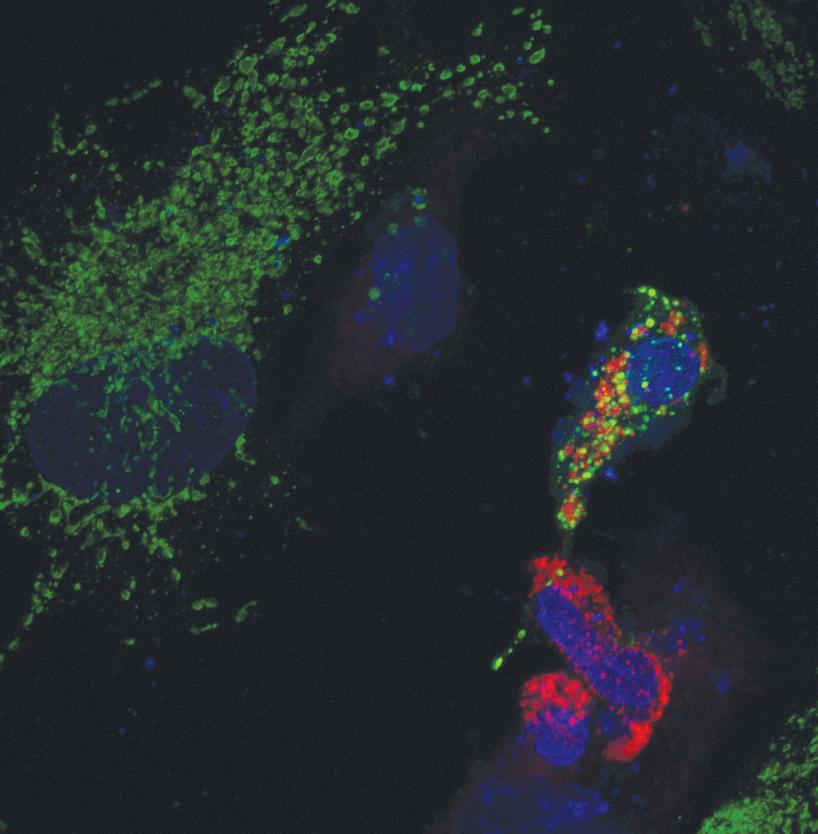
3 minute read
Mitochondria Mysteries
Toward Solving the
Mysteries of the Mitochondria
Advertisement
By adaM SHEllEy
One of the grandest works of the modern age is our understanding of the cell. Medicine, biology, and much of human health and wellness rests on the details of that smallest of machines. But how well do we understand what powers those cells? And what happens when that power source bites the bullet?
Blake Hill, associate professor of biology in the Krieger School of Arts and Sciences at Johns Hopkins University and affiliated faculty member of Johns Hopkins Institute for NanoBioTechnology, came to this question from an unusual angle. Originally a student of biochemistry, he worked under William DeGrado at the University of Pennsylvania on a far different problem: the nature of proteins inside the cell, and if it was possible to make artificial proteins.
“DeGrado’s research focuses on building proteins from scratch,” Hill explained. “We should be able to design functioning, native proteins.”
These attempts at protein design led Hill to work heavily in understanding why a protein folds the way it does and the difficulties one encounters: in particular, a sometimes overlooked problem where a single protein can be folded in multiple ways, giving it different properties. When designing proteins these multiple folding arrangements are a great difficulty that must be overcome as it prevents easy prediction of the final structure.
At other times though, when studying the cell’s own proteins, these transformations from one arrangement to another are key to understanding what’s going on. One such time when proteins rearrange themselves is in the mitochondria, the power plant of the cell, when the cell is dying.
“That’s what led us to the fundamental biological question: how mitochondria maintain their size and shape in living and dying cells,” Hill said.
The mitochondria are a part of the cell that has always been an oddball in their behavior. While they are critical for keeping us alive, transforming sugar and raw materials into energy, they are a world apart from the rest of the cell. With their own separate genetic code, hundreds of unique proteins and an unusual process of joining together and splitting apart from the rest of the cell’s cycle, the mitochondria behave like few other things.
In addition to their oddities in life, their mechanisms for dying are equally unique. In a process currently under study by many, including Hill, some proteins on the mitochondria’s surface are “multi-state proteins’ which can re-fold into a new shape and be absorbed by the mitochondria. In the case of one protein, Bcl-xL in particular, BAX, we know that in the end this creates large changes in the mitochondria as a whole and leads to the mitochondria’s death.
However, the ‘how’ and ‘why’ of this protein’s behavior is still in many ways a mystery. As Hill admitted, “We have no idea what they’re doing at the mitochondrial membrane. It’s one of the most studied proteins in the last ten years, and we still don’t know.” Here, the question of how and why it folds the ways it does could yet bring great insight into the field, and this question is a deadly serious one. With a firm understanding of how cells die, and how they are told to die, new horizons of treatment options for a variety of diseases may open up.
“Cells have an innate suicide mechanism.” Hill explains. “The body needs to maintain tight control of this process.” Too many cells being told to die can kill off the wrong cells and lead to diseases like Alzheimer’s. If there are too few cells dying, there are many other problems. Cancer, almost by definition, is what occurs when cells do not respond to signals to die. Also virtually every viral defense the body has relies on instructing the right infected cells to die at the right time, while the virus tries to stop this process.
If these key mitochondrial proteins are part of how a cell is told to die, then by activating them or suppressing them at the right times we may yet be able to tell the body how to correct a situation once it’s gone wrong. Currently one of the proteins under study in the Hill Laboratory, Bcl-xL, is a target for drug discovery with clinical trials under way.
Other aspects of mitochondrial behavior during cell death are further off from final medical applications, however, the potential is astounding and so work continues. It’s quite likely that it will only be a matter of time and of investigation, until these questions can be put to rest. ®

Adam Shelley is a NanoBio IGERT doctoral fellow in physics working in the Edidin Lab.










